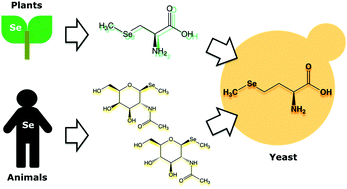Biotransformation of organic selenium compounds in budding yeast, Saccharomyces cerevisiae†
Abstract
Selenium (Se) is not essential for yeast growth, but it has a metabolic capacity to transform inorganic Se species to organic Se compounds such as selenomethionine (SeMet). Although the metabolism of inorganic Se species has been well discussed, there are no studies revealing how organic Se compounds are metabolized in yeast. The aim of this study was to show the specific metabolic pathway of organic Se species in yeast. We performed the speciation analysis of selenometabolites in budding yeast, Saccharomyces cerevisiae, exposed to selenometabolites produced by animals, plants, and microorganisms, such as methyl-2-acetamido-2-deoxy-1-seleno-β-D-galactopyranoside (SeSug1, selenosugar 1), methyl-2-acetamido-2-deoxy-1-seleno-β-D-glucopyranoside (SeSug2, selenosugar 2), trimethylselenonium ions (TMSe), Se-methylselenocysteine (MeSeCys), and SeMet. Four selenometabolites, SeSug1, SeSug2, SeMet, and MeSeCys, were commonly metabolized into SeMet in yeast. Yeast was able to incorporate TMSe but could not metabolize it. Since MeSeCys and selenosugars are the major selenometabolites in plants and animals, respectively, yeast is useful for recovering Se as SeMet from the selenometabolites produced by other organisms in the ecosystem.

- This article is part of the themed collection: Metallomics in Japan


 Please wait while we load your content...
Please wait while we load your content...